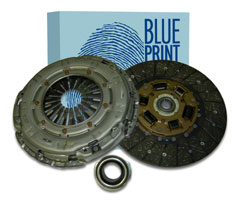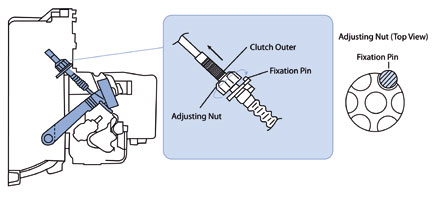
APPLICABLE MODELS: Toyota Aygo/Citroën C1/Peugeot 107
REFERENCES: ADT330246
ENGINE: 1.0i Petrol (KGB10, 1KR-FE)
GEARBOX: 5 Speed Manual
ENGINE: 2005>
 The Toyota Aygo (KGB10), which shares a platform with the Citroën C1 and Peugeot 107, is known to suffer from premature clutch disc wear. Drivers have also been known to complain about clutch noise. This is attributed to release bearing ‘squeak’, which is caused by a worn clutch cover diaphragm spring and/or a broken release bearing tab, making the clutch feel heavy and difficult to change gear.
The Toyota Aygo (KGB10), which shares a platform with the Citroën C1 and Peugeot 107, is known to suffer from premature clutch disc wear. Drivers have also been known to complain about clutch noise. This is attributed to release bearing ‘squeak’, which is caused by a worn clutch cover diaphragm spring and/or a broken release bearing tab, making the clutch feel heavy and difficult to change gear.
Blue Print advises that if you are working on an Aygo, C1 or 107 that has symptoms relating to a worn clutch disc, then a complete clutch kit replacement is required. It is also recommended that if you’re replacing the clutch kit, or the complaints relate to the symptoms highlighted above, then the clutch fork must also be checked and replaced if necessary. In this situation the increased effort required to change gear may result in stress fractures in the fork.
Please note: The manufacturer has issued a service bulletin to highlight that the design of the fork has been improved to prevent future issues, therefore if you fit a new fork, make sure it’s the modified OE version.
A production change on the clutch fork took place in June 2013 and a second service bulletin – regarding clutch disc wear – has since been issued by the manufacturer. To maximise the service life of the clutch disc, they have replaced the original 180mm diameter disc with the 190mm disc used on the Yaris (KSP90).
Blue Print’s clutch kit ADT330246 for these applications is only supplied with the 190mm clutch assembly.
Please note: With the larger clutch disc installed the clutch engagement point will be 15-20mm lower, which could be noticed by the driver. Also, because of the increase in diameter it is essential to check the condition of the flywheel and, if required, replace it or have it professionally machined.

When fitting the new release bearing you must follow these guidelines:
1. Apply clutch spline grease only to the input shaft splines.
2. Do not apply the grease to the release bearing or other parts of the input shaft.
CLUTCH FORK
Finally, the manufacturer issued a third bulletin which highlights that the lifetime of the clutch disc can be extended further. In all instances – whether the vehicle is in for a service (every 9,000 miles) or a clutch replacement – the clutch pedal free play must be checked and adjusted. If there is no free play, clutch disc wear increases.
In June 2013 a production change on the Toyota Aygo clutch fork took place which was effective on transmission numbers: 20TT012557203 and 20TT052557196

The procedure to check and adjust clutch pedal free play is as follows:
1. Push the clutch pedal down by hand (above left) checking for smoothness of operation. Stiffness or roughness in operation will require further investigation to determine the root cause.
2. Measuring the free play in the pedal can be done quickly and easily by applying gentle force to the pedal with your hand (approx. 15-20Nm) until you feel the amount of pressure required increase. Measure the distance travelled by the pedal with a ruler – the amount of free play in the clutch pedal needs to be 23mm, +/- 5mm (above right).

Ensure the adjusting nut is locked back in place on
the fixation pin after making any adjustments
Adjusting the clutch cable:
1. Pull the clutch outer cable until it is released from the Fixation Pin (approx 3mm).
2. Rotate the adjusting nut to increase or decrease the free play as necessary (1 full turn of the adjusting nut is equivalent to about 6.5mm of pedal free play).
3. Ensure the adjusting nut is locked back in place on the fixation pin after adjustment.
4. Operate the clutch 2-3 times.
5. Re-measure the clutch pedal free play and adjust as necessary.
Please note: After adjustment, the clutch pedal may be higher than the brake pedal – this is normal.









